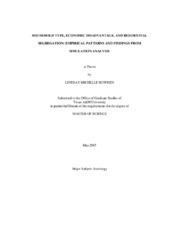| dc.description.abstract | In this thesis I focus on segregation between households giving attention to the
roles that family type, economic inequality, and race can play in promoting and
maintaining these patterns. I first consider three lines of urban ecological theory that
have been offered to help explain patterns of segregation. One line of theory emphasizes
the role of variation in preferences and needs. The second emphasizes urban structure,
market dynamics, and economic inequality, while the third emphasizes the role of race.
Research examining the role of consumer preferences in the neighborhood and housing
choices of Americans has documented the salience of preferences regarding housing
characteristics, neighborhood income, distance to employment, and neighborhood racial
composition. Related research shows that these preferences vary with social
characteristics such as socioeconomic status, ethnicity, gender, stage in the life cycle,
and household type. I review these literatures and link them with urban ecological
theory and the related literatures on social area analysis and factorial ecology. These
theories argue that households within a city are likely to cluster together in space based
on mutually shared characteristics and preferences. To explore these theories, I draw oncensus data for Houston, Texas and use the xPx measure to document patterns of contact
between households based on family type, poverty status, and race. I also decompose
the effects that each of these variables can have separately and in combination with each
other. Following this analysis, I estimate a spatial attainment model that predicts
characteristics of neighborhoods that individuals in each of the race, poverty and family
type groups would live in. Finally, I use computer simulation methods to explore how
micro-level dynamics of housing markets can produce patterns of segregation between
groups who are similar in their location preferences. Specifically, I explore how the
factors of area stratification and group income inequality can lead to segregation
between groups who hold similar location preferences. | en |


